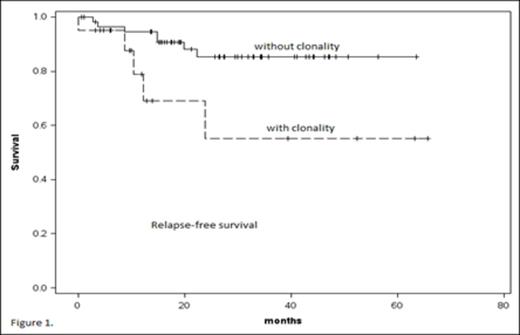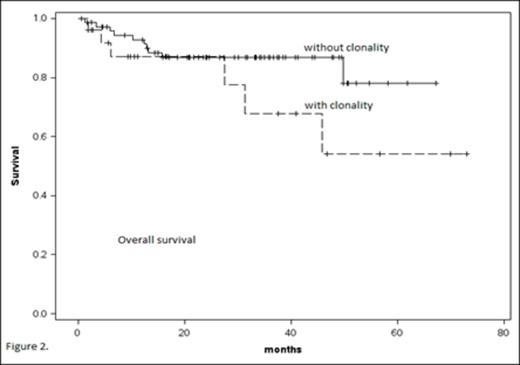Abstract
Introduction: Detection of bone marrow involvement (BM) is a factor of poor prognosis for diffuse large B-cell lymphoma (DLBCL), since DLBCL BM is characterized by aggressive course and low response level to standard chemotherapy (CT), and 5-year overall survival (OS) rate for this group is less than 30% after ÑHOP-like CT. Intensification of therapy in this group of patients can improve the results, except patients with bone marrow involvement at diagnosis. Bone marrow involvement is a poor prognostic factor for patients treated with high-dose chemotherapy.
Bone marrow involvement in DLBCL by histology is detected in 10-30% patients. The importance of B-cell clonality examination in bone marrow as prognostic and staging factor has not been described in the literature.
Aim: To evaluate the significance of the immunoglobulin heavy chain gene rearrangement analysis performed by PCR for identification of the bone marrow involvement frequency and its value for staging and prognosis in patients with de novo DLBCL treated with high-dose chemotherapy (HDC).
Patients and methods: We performed a pilot prospective trial, including 175 consecutive adult patients (median age 45 years, range 18–67) with newly diagnosed DLBCL who were enrolled in HDC protocol (mNHL-BFM-90 program or scheme R-EPOCH/R-HMA) since June 2007 till July 2014. Their clinical characteristics included such factors as IPI and phenotype DLBCL by immunohistochemical study. Out of the 175 patients, 85 had a GCB phenotype and 90 - non-GCB; 36 patients (20%) had low IPI risk, 40 patients (23%) had low-intermediate, 38 patients (22%) had high-intermediate, 61 patients (35%) had high risk.
B-cell clonality was evaluated using PCR amplification by IGH (FR1, FR2, FR3) and IGK (Vκ-Jκ, Vκ/intron-Kde) gene rearrangements with multiplex BIOMED-2 primer sets and subsequent fragment analysis using ABI PRISM 3130 Genetic Analyzer (Applied Biosystems).In 105 of 175 patients the study by BIOMED-2 multiplex polymerase chain reaction protocol of B-cell clonality of bone marrow was fulfilled. Statistical analysis was done using JMP ver. 10.0 (SAS, Cary, NC).
Results: Histological and immunohistochemical studies validated bone marrow involvement in 19 patients (10.8%), including: concordant in - 12 patients (63%), and discordant - in 7 patients (37%). In 14 of these patients the B-cell clonality detection was performed and confirmed immunoglobulin (IG) heavy chain gene rearrangement in all cases. In 26 out of 105 patients, bone marrow involvement (24.7%) was revealed: in 14 patients bone marrow involvement was identified by histological examination and in 12 patients only by clonality of bone marrow. 12 patients with only B-cell clonality in bone marrow were classified by IPI: 4 (33%) patients had high IPI, 6 (50%) patients - high-intermediate IPI and low-intermediate IPI - 2 (17%) patients. So, in 17% patients had to change the risk group according to bone marrow involvement. Thus, 31 patients with bone marrow involvement signs were identified.
Univariate analysis of the entire cohort (n = 175) revealed that both IPI and phenotype were not of prognostic significance (p > 0.05). In multivariate analysis, detection of B-cell clonality in bone marrow was an independent predictor of OS and relapse-free survival (RFS) (p < 0.005). (Fig.1-2). OS, RFS in patients with histological detection bone marrow involvement and with only B-cell clonality in the bone marrow did not differ.
Conclusion:Detection of B-cell clonality in the bone marrow seems to be an independent predictor of outcome in de novo DLBCL pts, treated with high-dose chemotherapy, while IPI and phenotype DLBCL cannot be considered as risk factors for this group of pts. It seems to be reasonable to include the detection of B-cell clonality in the bone marrow in primary diagnostics of the DLBCL for staging and predicting response in HDC.
No relevant conflicts of interest to declare.
Author notes
Asterisk with author names denotes non-ASH members.



This feature is available to Subscribers Only
Sign In or Create an Account Close Modal